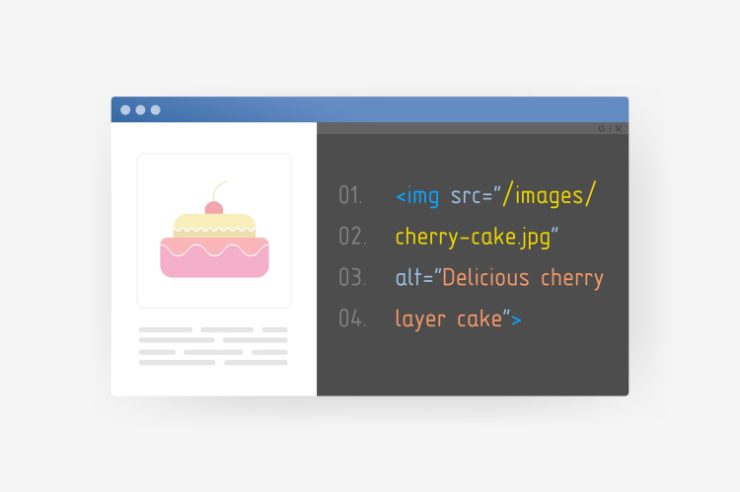Ensuring accessibility for all users is not just a courtesy—it’s a necessity. With the rise of the Americans with Disabilities Act (ADA) standards, implementing ADA alt text best practices has become a critical aspect of web design and content creation. From decorative and functional to informative, complex, and groups of images, you’ll learn how to craft meaningful, context-specific alt text that enhances user experience, ensures ADA compliance, and improves your site’s SEO performance.
What is Alt Text?

Alt text, short for alternative text, serves as a critical component of web accessibility, offering textual descriptions of images for users who rely on screen readers due to visual impairments, which not only aids in navigating digital content but also plays a crucial role in providing a complete understanding of the web page’s visual elements. This functionality is not merely a feature but a fundamental aspect of web accessibility, as mandated by the Americans with Disabilities Act (ADA) guidelines for digital content.
Beyond accessibility, alt text is integral to search engine optimization (SEO). It allows search engines to index the image content, enhancing the website’s visibility in search results. It also serves as a fallback if the image fails to load, ensuring users still grasp its intended message or function.
Types of Images and Corresponding Alt Text Strategies
Creating accessible web content requires a nuanced understanding of how different types of images contribute to your website’s overall user experience. Each image type serves a unique purpose and necessitates a distinct approach to alt text. Let’s explore the various categories of images you might encounter and the ADA alt text best practices for each.
Alt Text Best Practices for Decorative Images
Decorative images enrich the visual layout of a website, adding aesthetic value without directly contributing to the content’s informational substance. Below, we explore varied contexts in which decorative images are used and outline best practices for assigning alt text to ensure an accessible web experience for all users. First, here are the ADA best practices for decorative image alt text:
Adopting Empty Alt Attributes: For images that purely serve decorative purposes, the best practice is to employ an empty alt attribute (alt=””). This method effectively communicates to assistive technologies that the image can be bypassed, thus streamlining the navigation for users relying on these tools.
Prioritizing CSS for Decorations: Instead of embedding decorative visuals directly within HTML through the <img> tag, leveraging CSS for such embellishments ensures that they are naturally omitted by screen readers, thereby enhancing site accessibility.
Discerning Decorative Versus Informative Roles: The distinction between whether an image is decorative or holds informative value is crucial and hinges on its contribution to the page’s content or narrative.
Best Practices Based on Scenario
Let’s discuss some scenarios and ADA best practices for decorative imagery alt text.
Mood Setting Through Imagery
- Scenario: A panoramic skyline photo used to convey the bustling energy of a city in a travel blog.
- Best Practice: When the image’s role is to set a mood or theme rather than to inform, it should be marked with alt=””. If specific details in the image are crucial to the content, consider providing a descriptive alt text.
Visual Complements to Textual Content
- Scenario: An icon of a leaf next to a section titled “Sustainability Efforts.”
- Best Practice: If the icon is purely for visual emphasis and the section title is self-explanatory, assigning alt=”” ensures the icon doesn’t distract assistive technology users.
Enhancing Clickable Areas with Imagery
- Scenario: A small graphical arrow next to “Read More” links to increase the clickable area.
- Best Practice: Such images should be accompanied by alt=”” to avoid unnecessary screen reader focus, relying instead on the textual link for navigation.
Page Design Images
- Scenario: Patterns or shapes used in the background or as section dividers within a webpage.
- Best Practice: Utilize CSS where possible for these visual elements, or mark them with alt=”” when using <img> tags to ensure they’re not read by screen readers.
Additional Considerations
Interactive Decorative Elements: For decorative elements that are part of interactive controls, ensure the controls themselves are adequately labeled with accessible text, focusing on their function over form.
Reevaluating Context: Always reevaluate an image’s role based on its context within the webpage. An image considered decorative in one setting may be informative in another, underscoring the importance of context in alt text decisions.
Remember, empty alt attributes mean that search engines will also skip over these images. Ensure that images containing important keywords or content for SEO purposes are correctly marked as informative and provided with relevant alt text.
Best Practices for Informative Image Alt Text

Informative images are pivotal in web content, elucidate concepts, complement narratives, and enhance understanding. They range from diagrams illustrating complex ideas to icons signifying specific actions. Crafting ADA-compliant alt text for these images ensures that all users can grasp their significance regardless of visual ability. Here are some guiding principles for informative image alt text:
Conciseness and Clarity: Aim for alt text that succinctly describes the image’s conveyed information or concept, avoiding overly detailed or vague descriptions.
Contextual Relevance: Tailor alt text to the image’s role within the content, ensuring it complements the surrounding narrative or information. Often, the alt text isn’t going to be a literal description of the provided imagery.
Avoiding Redundancy: Ensure the alt text does not simply repeat information already provided in the text, but rather adds value or context.
Best Practices for Different Scenarios
Supplementing Information with Images
- Scenario: A bicycle equipped with an LED light, accompanied by safety tips for night cycling.
- Best Practice: Alt text, like “Bicycle with LED light for safe night cycling,” should complement the safety tips, adding a visual cue to the advice.
Conveying Information Succinctly
- Scenario: An icon indicating the storage requirement to keep a product refrigerated.
- Best Practice: The alt text should provide succinct information about the requirement, such as “Icon: Keep refrigerated,” directly conveying the necessary storage condition.
Eliciting Emotion or Impression
- Scenario: An image showcasing a peaceful reading nook within a bookstore to convey its welcoming atmosphere.
- Best Practice: The alt text, “Cozy reading nook in bookstore,” should capture the space’s warmth and inviting nature and aim to evoke a specific ambiance.
Labeling Information with Icons
- Scenario: Email and physical address icons beside contact details.
- Best Practice: The alt text should clearly label what each icon represents, such as “Email icon” and “Location icon,” helping users identify the type of information provided.
Indicating File Formats
- Scenario: Icons denoting that an article is available in audio format and as a downloadable eBook.
- Best Practice: Alt text should differentiate the formats, using phrases like “Audio format available” and “Download eBook version,” making it clear what options are available for accessing the content.
Additional Insights
Distinguishing Between Informative and Decorative: Continuously assess the image’s role, recognizing that what may be informative in one context could be decorative in another.
Labeling for Accessibility and SEO: While informative images enhance accessibility, their alt text can also support SEO. Ensure the alt text includes relevant keywords without sacrificing clarity or relevance.
Leveraging Long Descriptions for Complex Images: For images too detailed for brief alt text, consider using a long description link or adjacent detailed text, ensuring comprehensive accessibility.
Adhering to these best practices enables content creators to effectively communicate the informational value of images to all users, aligning with accessibility standards and enhancing the overall user experience.
Best Practices for Functional Image Alt Text
Functional images serve a unique role on websites and applications. They act as interactive elements that initiate actions, like navigating to another page, submitting a form, or performing a specific function. Crafting effective alt text for these images is crucial for accessibility, ensuring all users understand the actions they can take, regardless of their ability to see the images.
Functional images include buttons, icons within links, and any visual element that triggers an action. The alt text for these images must focus on the action or outcome they facilitate rather than their appearance. Here are some ADA alt text best practices for functional images:
Action-Oriented Language: Use verbs that clearly indicate the action or result of interacting with the image, helping users predict what will happen when they activate the control.
Brevity and Directness: Keep the alt text concise, directly linking the description to the function without unnecessary detail.
Avoid Visual Descriptions: Users need to know what an image does, not what it looks like. Focus on function over form.
Scenarios and Best Practices
Download Links
- Scenario: A download icon next to a link for downloading a document.
- Best Practice: Use alt text like “Download PDF” to indicate both the action (download) and the file type.
Navigational Icons
- Scenario: An icon used as a link to take the user back to the homepage.
- Best Practice: Alt text should say “Go to homepage” instead of describing the icon’s appearance.
Social Media Links
- Scenario: Icons linking to social media profiles.
- Best Practice: Alt text should specify the action and destination, like “Visit our Twitter page.
Opening External Links
- Scenario: An icon indicating that a link opens in a new tab.
- Best Practice: Alt text should inform about the link’s behavior, such as “Opens in a new tab,” ensuring users are not surprised by the change in context.
Interactive Controls
- Scenario: A button that submits a form.
- Best Practice: The alt text for an image used within the submit button should be “Submit form,” clearly stating the button’s function.
Additional Insights
Contextual Clarity: Ensure the alt text makes sense within the surrounding content, providing users with clear guidance on what each functional image does.
Consistency: Maintain consistent phrasing for similar actions across your website to help users quickly understand each function.
By adhering to these ADA alt text best practices, content creators and developers can ensure functional images on their sites are accessible and understandable to all users, enhancing navigation and interaction for everyone.
Best Practices for Complex Image Alt Text

Complex images such as detailed charts, intricate diagrams, or comprehensive maps carry substantial information, demanding a nuanced approach to alt text. These images necessitate a strategy that balances a succinct overview with access to detailed descriptions for full accessibility. Here, we expand upon the foundational guidelines with varied examples and a focus on different approaches to providing detailed descriptions. Here are the ADA alt text best practices you should know for complex images:
Short Description for Immediate Understanding: Provide a concise alt text that offers a brief overview of the image’s content.
Detailed Descriptions for Comprehensive Insight: Supplement with a more elaborate explanation that conveys all necessary details of the complex image. There are several different approaches for providing detailed descriptions, which we will discuss.
Scenarios and Approaches
Detailed Graphs and Charts
- Scenario: A complex graph detailing the growth of renewable energy usage over the last decade.
- Best Practice: Short alt text like “Graph of renewable energy growth from 2010 to 2020” should be complemented with a detailed explanation available through a separate link, an adjacent text description, or the longdesc attribute.
Intricate Diagrams
- Scenario: A detailed wiring diagram for a solar panel installation.
- Best Practice: Use alt text such as “Wiring diagram for solar panel installation,” with a detailed description provided in the content or via a linked detailed description
Comprehensive Maps
- Scenario: An interactive map showing deforestation areas in the Amazon.
- Best Practice: Alt text could be “Interactive map of Amazon deforestation areas,” with an extensive description detailing the specific areas affected, the percentage of deforestation, and other critical data either embedded in the page or accessible through a link.
5 Different Approaches for Providing Detailed Descriptions
1. Adjacent Detailed Description:
- Place a comprehensive description directly in the content following the image. This method ensures the information is readily accessible to all users, including those using screen readers.
2. Link to Detailed Description:
- Provide a hyperlink immediately after the image or within the alt text (if supported by the screen reader) that navigates to a full description. This could link to a separate page or a specific section within the same page.
3. HTML5 <figure> and <figcaption>:
- Use the <figure> element to contain the image and the <figcaption> element to provide a brief caption or link to a more detailed description. This semantic markup helps screen readers understand the relationship between the image and its description.
4. longdesc Attribute:
- Utilize the longdesc attribute of the <img> tag to provide a URL to a detailed description of the image. However, support for longdesc is variable across different browsers and screen readers.
5. ARIA aria-describedby Attribute:
- Employ the aria-describedby attribute to associate the image with a detailed description provided elsewhere on the page. This method links the image to the ID of an element that contains the description, facilitating a direct connection for screen readers.
Adopting these ADA alt text best practices ensures that complex images on websites are accessible, providing all users, regardless of their visual capabilities, with a complete understanding of the content conveyed by these images.
Best Practices for Alt Text with Groups of Images
When utilizing groups of images on web content, it’s essential to ensure that the collection is accessible to all users, including those using assistive technologies like screen readers. Groups of images, whether conveying a single piece of information or a series of related images, require careful consideration regarding alt text to ensure comprehension and navigation are seamless for every user. These are the ADA alt text best practices for groups of images:
Single Information Representation: When multiple images represent a single piece of information (like a star rating system), only the first image requires descriptive alt text that encapsulates the collective information. Subsequent images in the series should use a null alt attribute (alt=””) to prevent repetitive or unnecessary narration by screen readers.
Related Images Collection: For collections of images that each convey distinct yet thematically related information, each image should have its unique alt text. This alt text should describe the individual image and briefly touch on its relation to the group’s overall theme or narrative.
Scenarios and Implementation Strategies
Groups Of Images That Mean One Thing
- Scenario: A group of images displaying a rating system, where five icons collectively represent a product’s rating out of five.
- Best Practice: The first icon in the sequence should have alt text that describes the overall rating, such as “Rated 4 out of 5 stars.” The remaining icons should utilize an empty alt attribute to ensure they are skipped by screen readers, thus avoiding redundancy.
Thematic Image Collections
- Scenario: A web page features a collection of images showcasing different stages of a garden’s growth over a year.
- Best Practice: Each image should have alt text describing the specific stage it represents, e.g., “Early spring garden beginning to bloom.” Additionally, consider grouping the images using the <figure> and <figcaption> elements, with aria-labelledby to link each image to its caption for clarity and context.
Additional Considerations
- Use of HTML5 and ARIA: Utilize the HTML5 <figure> and <figcaption> elements to semantically group images and their captions. Employ ARIA attributes like aria-labelledby to enhance the association between images and their detailed descriptions or thematic grouping.
- Non-Textual Elements: For non-textual elements like decorative borders or spacers within a group, ensure these are marked with a null alt attribute or implemented via CSS to be inherently ignored by screen readers.
By adhering to these ADA alt text best practices, content creators can enhance the accessibility of grouped images, ensuring that all users, regardless of how they access web content, receive a full and rich experience of the visual narrative or information presented.
Best Practices for Image Maps Alt Text
Image maps offer a unique way to navigate web content through images divided into clickable regions. Each region, defined by <area> tags, serves as a gateway to more detailed pages or sections of the site. To ensure accessibility for all users, including those using screen readers, providing clear and informative alt text is essential. Let’s explore ADA alt text best practices for image maps:
Descriptive Alt for the Image: The primary <img> tag should have alt text that offers a general overview of the image map’s purpose, such as “Interactive campus map.”
Specific Alt for Each Area: Every <area> within the map must have its own alt text that describes the action or destination, for example, “Go to the library section.”
Implementing Alt Text in Image Maps
Contextual Overview
- Scenario: A zoo layout with different sections that are clickable for more information.
- Best Practice: The image should carry alt text like “Zoo layout map,” and each clickable area should detail the section it represents, e.g., alt=”Visit the lion’s den.”
Functional Navigation
- Scenario: An illustrated guide for a software’s features, where parts of the image lead to tutorials.
- Best Practice: The overall image should be described as “Feature guide of software X,” with each area providing specific navigation instructions, such as alt=”Tutorial on feature Y.”
Advanced Tips for Image Maps
Use Redundant Text Links: For accessibility and to ensure functionality across devices, including those that may not support image maps fully, provide a list of text links mirroring the image map’s clickable areas.
Responsive Design Considerations: Ensure your image map scales properly across devices. If the image map resizes, the coordinates of the clickable areas must be adjusted accordingly to maintain accuracy.
Alt text in image maps bridges the gap between visual content and its navigational functions, making digital spaces more inclusive. By adhering to these ADA alt text best practices, developers can enhance the user experience for everyone, ensuring that all visitors can navigate their websites effectively and independently.
Implementing ADA Alt Text Best Practices
Alt text (alternative text) plays a critical role in making digital content accessible and ADA-compliant. Beyond its fundamental use in describing images for those who use screen readers, alt text also enhances the overall user experience and search engine optimization.
11 Tips for Effectively Adding Image Alt Text
Here are practical tips for leveraging alt text effectively, focusing on aspects not previously covered:
- Integrate Keywords Strategically: While the primary purpose of alt text is to provide context for images, incorporating relevant keywords can also boost SEO. Ensure the primary focus remains on accurate and descriptive text that benefits the user.
- Use Active Language: When appropriate, craft alt text in an active voice to create a more engaging and direct description. For example, “Chef prepares gourmet meal” can be more vivid than “Gourmet meal being prepared by a chef.”
- Avoid Keyword Stuffing: While keywords are important, avoid overloading your alt text with them. This practice can detract from the user experience and potentially harm your site’s search engine rankings.
- Be Mindful of Length: Keep alt text concise. Aim for descriptions that are informative yet brief, typically under 125 characters. This ensures that screen readers can convey the message effectively without overwhelming the user.
- Consider the Image’s Context: The same image may require different alt text depending on its context within the page. Always tailor the alt text to how the image contributes to the surrounding content.
- Avoid Redundant Phrases: Skip phrases like “image of” or “graphic of,” as screen readers already announce the element as an image. Directly start with the description to keep it succinct.
- Use Null Alt for Decorative Images: If an image is purely decorative and doesn’t convey important content or functionality, use an empty alt attribute (alt=””) to indicate that the image can be ignored by screen readers.
- Ensure Dynamically Loaded Content is Accessible: For images loaded dynamically via JavaScript or other web technologies, ensure alt attributes are also dynamically assigned to maintain accessibility.
- Regularly Review and Update Alt Text: As your website evolves, review and update alt text to ensure it remains relevant and accurate. This is particularly important for sites that frequently update their content.
- Educate Your Team: Make sure all content creators, web developers, and designers understand the importance of alt text and know how to implement it correctly. Creating guidelines or checklists can help maintain consistency and compliance across your site.
- Leverage Tools and Resources: Utilize web accessibility evaluation tools to check the effectiveness of your alt text and identify areas for improvement. ADA compliance scanning tools like WAVE or the Axe accessibility checker can provide valuable insights.
By following these tips, you can help ensure that your use of alt text aligns with ADA best practices for alt text, making your website more accessible and user-friendly for everyone.
What Happens If You Don’t Have ADA-Compliant Alt Text
Neglecting ADA-compliant alt text isn’t just an oversight; it may have tangible repercussions for businesses. The Americans with Disabilities Act (ADA) aims to ensure that individuals with disabilities have the same rights and opportunities as everyone else, which includes access to information and services provided through websites. Here’s what could happen if your business’s digital content fails to meet these standards:
Legal Fees and Settlements: Legal actions are perhaps the most direct financial consequence. The costs include lawyer fees, settlements, and potentially court-ordered damages. Settlements for ADA web accessibility lawsuits can range significantly, with figures from a few thousand to tens of thousands of dollars per case, not including the legal fees for defense.
Cost of Retrofitting for Compliance: Retrofitting a website to meet ADA standards, including the implementation of compliant alt text for images, may be costly. This process might involve a comprehensive audit, website redesign, development hours to correct accessibility issues, and testing by users with disabilities. For a large-sized business, retrofitting costs can easily reach tens of thousands of dollars, depending on the website’s complexity and the extent of non-compliance.
Loss of Revenue: Inaccessible websites limit the potential customer base, excluding users with disabilities who cannot navigate the site or access its information. This exclusion can lead to direct revenue loss, particularly if competitors offer more accessible alternatives. The exact impact varies based on the business size and market, but it can represent a significant percentage of potential online sales.
SEO Ranking Penalties: Inaccessible content can negatively impact a website’s search engine rankings. Search engines, including Google, factor in accessibility when ranking sites. Poor accessibility can lower a site’s visibility, leading to reduced traffic and potential sales losses. The cost is hard to quantify but can be substantial over time, especially for e-commerce sites or businesses heavily reliant on online leads.
Brand and Reputation Damage: The intangible costs of brand damage can have long-term financial implications. Negative publicity from failing to meet accessibility standards can deter potential customers and partners. Repairing a damaged reputation requires additional marketing and PR efforts, which can be costly.
Opportunity Costs: Non-compliance can result in missed opportunities, such as government contracts or partnerships with other businesses that require ADA compliance. These lost opportunities can have a significant financial impact, especially for B2B companies or vendors seeking to work with public sector organizations.
The cost consequences of not having ADA-compliant alt text and broader web accessibility range from direct financial outlays, such as legal fees and retrofitting costs, to more intangible impacts, like brand damage and lost revenue opportunities. Investing in accessibility not only avoids these costs but can also enhance brand reputation, widen the customer base, and improve overall user experience.
Work With An ADA Team
This guide has walked you through the various nuances of implementing ADA alt text best practices across different types of images, highlighting the significance of making your digital assets accessible to all.
However, understanding and implementing these practices can be challenging, particularly for businesses that must juggle this with their myriad other responsibilities. This is where Oyova steps in. Our team is dedicated to ensuring that your website not only meets ADA compliance standards but also offers a seamless, inclusive user experience. With our comprehensive ADA Compliance Audits & Remediation services, we help identify potential accessibility barriers on your website and work meticulously to eliminate them, ensuring that every visitor can navigate and enjoy your digital content without hindrance.
Contact us today to get started.
Disclaimer: The information provided in this blog is for general informational purposes only and is not intended as legal advice. The contents of this blog may not reflect the most current legal standards or interpretations. For specific legal advice regarding ADA compliance or other legal issues, please consult with a qualified attorney. Oyova does not guarantee the accuracy, completeness, or usefulness of any information on this site and is not responsible for any errors or omissions or for the results obtained from the use of this information.
